Intel Rocket Lake (14nm) Review: Core i9-11900K, Core i7-11700K, and Core i5-11600K
by Dr. Ian Cutress on March 30, 2021 10:03 AM EST- Posted in
- CPUs
- Intel
- LGA1200
- 11th Gen
- Rocket Lake
- Z590
- B560
- Core i9-11900K
Motherboards
All of these new processors are LGA1200 processors, and a result they will be enabled in 500-series motherboards. There is also some 400-series support, however it depends on the platform. Here’s the trusty AnandTech Guide for support:
| Motherboard Support | |||
| AnandTech | B460 H410 |
Z490 Q470 H470 |
Z590 B560 H510 |
| Comet Lake | Yes | Yes | Yes |
| Rocket Lake | No | Yes | Yes |
The reason why Rocket Lake will not work in H410 or B460 motherboards is because these chipsets are built on Intel’s older 22nm process. There is something in the design of those chipsets, likely to be related to signal integrity, which means they cannot be supported, at least at the PCIe 3.0 speeds required. Given previous motherboard firmware, we might see unofficial support later down the line, even if only in PCIe 2.0 mode.
However, the lead platform for Rocket Lake will be the Z590 platform. The new features boil down to:
- Double CPU-to-Chipset bandwidth when paired with 11th Gen RKL
- USB 3.2 Gen 2x2 (20 Gbps) native chipset connectivity
The new H570 and B560 motherboards reintroduce memory overclocking, a feature that was removed from the 400-series budget motherboards.
Here is the slide Intel provided for 500-series, though it is worth mentioning some of the caveats:
In this slide, it states that discrete Wi-Fi, 2.5 gigabit Ethernet, and Thunderbolt 4 are supported on 500 series. These are optional upgrades for the motherboard vendors, so not all motherboards will have them, and in each case they also require additional hardware costs for the motherboard manufacturer, such as an RF module for Wi-Fi, a PHY for Ethernet, or a PHY for Thunderbolt. These could all be added to any other motherboard, AMD or Intel, with discrete controllers which are slightly more expensive – those controllers don’t have to be Intel either. But to be clear, they are not unique to offerings to Z590, nor are they natively offered by default on all systems.
All of the 10th Generation Comet Lake processors will work in all 500-series motherboards, and get all the features, except the double CPU-to-Chipset bandwidth, as that specifically requires Z590 + 11th Gen Core CPU.
It should be noted that anyone already with a 400-series or 500-series motherboard, or those looking to purchase one, will need a BIOS update in order to enable the latest performance enhancements. In our testing, we found that the BIOS on our boards when they arrived in our offices were quite old (from January), and the latest microcode from Intel should help increase performance and cache latency. Some may be updated to February microcode, which does get most of the way there to peak performance, but the latest should always give the best results.
Intel Z590 and B560
The two main chipsets to focus on for Rocket Lake are the Z590 and B560 motherboards. The Z590 start at an eye-watering $175 and go up to over $1000, whereas the B560 are more palatable starting from $75 up to around $220.
Where the B560 and Z590 differ is in some of the PCIe bifurcation (x16 only on B560), the number of USB ports, and the chipset number of PCIe 3.0 lanes available for M.2 or additional controllers.
| Intel 500-Series Chipset | |||
| Feature | B560 | Z590 | Z490 |
| Socket | LGA1200 | LGA1200 | LGA1200 |
| PCIe Lanes (CPU) | 20 | 20 | 16 |
| PCIe Specification (CPU) | 4.0 | 4.0 | 3.0* |
| PCIe Config | x16 x16/+4 |
x16 x8/x8 x8/x8/x4+4 |
x16 x8/x8 x8/x8/+4 |
| DMI Lanes (3.0) | x4 | x8 (RKL) x4 (CML) |
x4 |
| Chipset PCIe 3.0 Lanes | 12 | 24 | 24 |
| Max USB 3.2 (Gen2/Gen1) | 4/6 | 6/10 | 6/10 |
| USB 3.2 Gen 2x2 (20 Gbps) | Y | Y | ASMedia |
| Total USB | 12 | 14 | 14 |
| Max SATA Ports | 6 | 6 | 6 |
| Memory Channels (Dual) | 2/2 | 2/2 | 2/2 |
| Intel Optane Memory Support | Y | Y | Y |
| Intel Rapid Storage Technology (RST) | Y | Y | Y |
| Integrated WiFi MAC | Wi-Fi 6 | Wi-Fi 6 | Wi-Fi 6 |
| Intel Smart Sound | Y | Y | Y |
| Overclocking Support | *Memory | Y | Y |
| Intel vPro | N | N | N |
| Max HSIO Lanes | ? | ? | 30 |
| ME Firmware | 15 | 15 | 14 |
| TDP (W) | 6 | 6 | 6 |
We’ve gone through all 90+ motherboards from both chipsets, and collated them into two large overviews:
- The Intel Z590 Motherboard Overview (50+ Models)
- The Intel B560 Motherboard Overview (40+ Models)
These are all the details on all the motherboards we’ve been able to identify as coming to market. Note that not all will be available in every region, with some being OEM/customer specific and might only be available on the OEM market.
By and large, we have observed several key metrics worth discussing with the new motherboards.
First is the large uptake of 2.5 gigabit Ethernet. It has taken literal years since the first consumer 2.5 GbE solutions came to market with Aquantia, and they were limited to select motherboards at a premium price point. Now we are seeing Intel and Realtek-based 2.5 GbE controllers make their way down to something more affordable. More and more NAS and routers are coming with one or more 2.5 GbE ports as standard, and as more systems get enabled with higher speed for wired connectivity, we should see the market open up a lot more. It won’t improve your internet speed, but it might improve home streaming with the right network configuration.
The other element these boards bring is USB 3.2 Gen 2x2 (20 Gbps). This is the double speed ‘USB 3.2’ standard that was renamed, and now we get this feature native on 500-series chipsets. It was only previously possible with additional ASMedia controllers, but now Intel motherboards can have them, but only if the motherboard vendor enables it. We’re seeing mostly front-panel connections adhere to this standard, but a few motherboards have it available as a Type-C connection on the rear panel.
Also of note is that the B560 motherboards are now enabling memory overclocking again, which was removed in B460. Any 10th Gen or 11th Gen processor in a B560 can have overclocked memory. CPU overclocking is still limited to the Z-series motherboards.
Overclocking Enhancements For Memory: Ratios
On the Overclocking Enhancement side of things, this is perhaps where it gets a bit nuanced. For a while now Intel has been binning its K processors to within an inch of their maximum supported frequencies, and turbo boost techniques like favored core and Thermal Velocity Boost also push the margins on the cores that support it. So what can Intel focus on for overclocking this time round?
With Rocket Lake, Intel is leaning into the memory side of things. These new Rocket Lake processors now support geared ratios between the memory controller and the DRAM data rates. Users can either select a 1:1 ratio or a 2:1 ratio.
Traditionally Intel has natively operated on a 1:1 ratio without ever giving users the option. This meant that in order to push that DDR4-5000 memory, like we did in our review of that premium Corsair kit, it required a processor with a good memory controller that could also support a 5.0 GT/s connection.
With the 2:1 ratio, the memory controller will now operate at half speed, in a more comfortable zone, allowing memory overclockers to go beyond traditional limits. With that DDR4-5000 memory, it means that the memory controller is now only operating at 2.5 GT/s (1250 MHz because DDR4 is measured in transfers per second, and there are two transfers per clock in Double Data Rate DDR memory). This also means that in order to match the internal clocks on DDR4-3200, users will have to start pushing the memory itself to DDR4-6400 to get the memory controller back on a level footing when in that 2:1 ratio. Nevertheless, this feature does allow the memory to be tested to its limits without the bottleneck of the CPU.
By default, all Rocket Lake processors will support DDR4-2933 at a 1:1 ratio in the specifications. Above this will mean a 2:1 ratio, except for the Core i9 family, which allows for a DDR4-3200 1:1 ratio. Despite these specifications, every motherboard we tested puts DDR4-3200 on a 1:1 ratio for all CPUs, so the delineation between the Core i9 and the rest seems arbitrary.
Overclocking Enhancements For Memory: Dual POST
Users that have tried memory overclocking will note that in order to change the memory ratio, it requires a restart. With the new Z590 system, Intel has devised a system that will let a user select two different memory ratios, and it will enable both at boot time.
Under this mode, once in the operating system, a user can switch between them for different benchmarking modes. What this does is allow extreme overclockers, particularly those going for world records with sub-zero coolants, to boot at the lower memory speed, then run the test at a higher memory speed, then instantly revert back to the slow speed. Currently they have to run at the high speed all the time, which can be liable to instability. It’s more one for the extreme overclockers, but Intel has added it here.
Other Overclocking Enhancements
Other new features in the overclocking toolkit include AVX-512 offsets and voltage guard bands, enabling users to overclock the processors without overclocking AVX-512 and incurring a heavy power consumption penalty. Intel has also put in an option to disable AVX altogether, which means that users who don’t want to worry about AVX-512 draining almost 300 W from an errantly loaded program, it can be disabled directly in the firmware.
Intel is also continuing support for a number of overclock-related features, such as per-core HyperThreading, per-core frequency adjustment, and fine-grained PLL controls. Intel has stated that with Rocket Lake, it has opened up some of the features to enable proper BCLK overclocking again, however we wait to see if there is a good range for overclockers to play with.
All these new features are enabled when a 500-series motherboard and a new Rocket Lake 11th Generation Core processor. Support with Comet Lake will be limited.


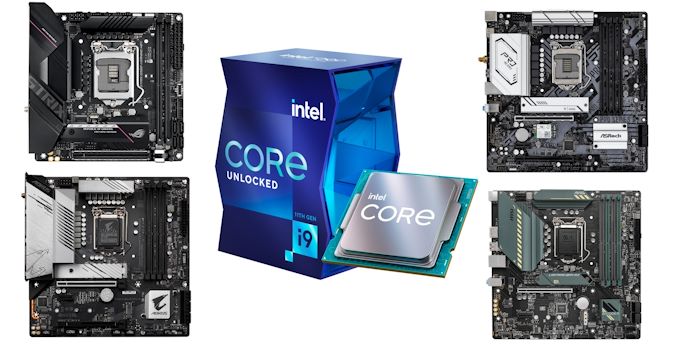
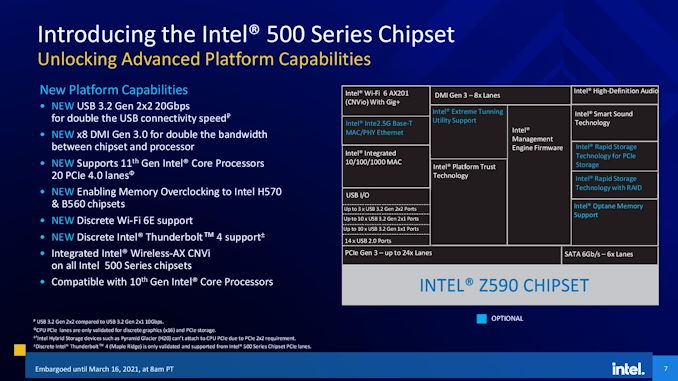
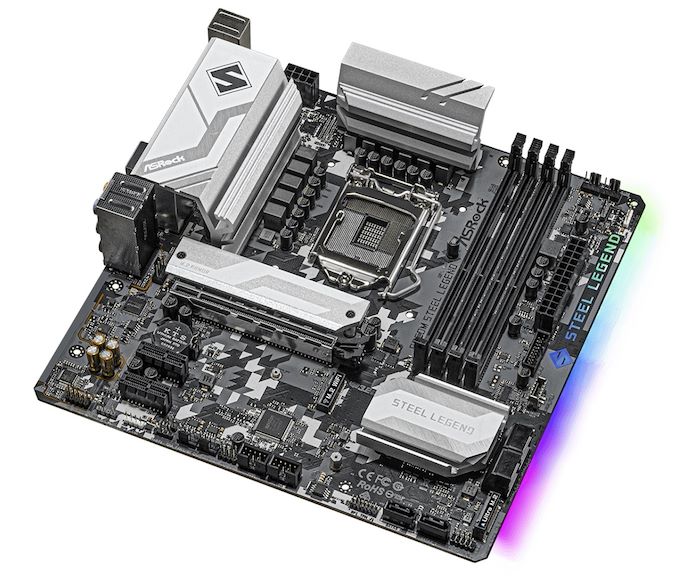
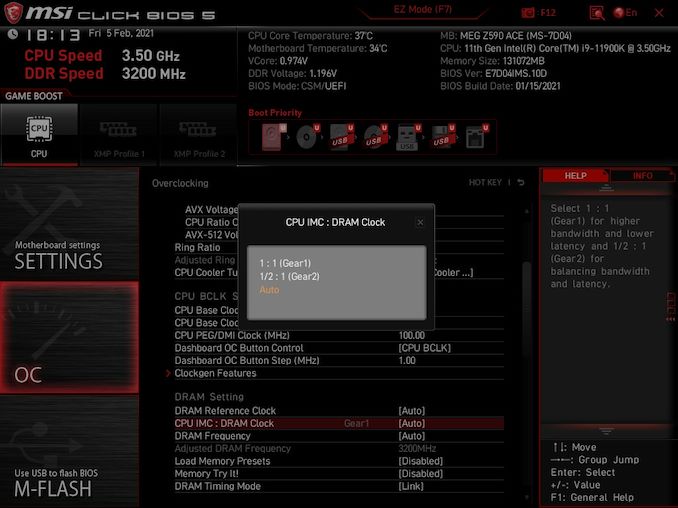
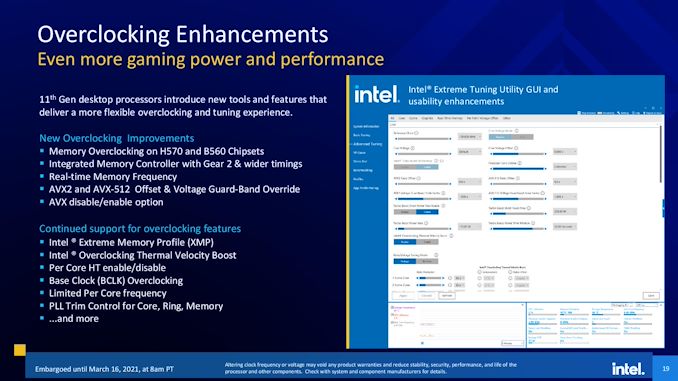








279 Comments
View All Comments
blppt - Tuesday, March 30, 2021 - link
I disagree. I had a 9590 (which shipped WITH a small AIO cooler!) and the thing was shaky at best for stability, easily topping 90c at stock settings.Not the mobo fault either, I had the top end ASUS CHVF-Z 990FX, which was such a mature chipset it practically had grey hairs.
TheinsanegamerN - Wednesday, March 31, 2021 - link
the 9000 series all had stability issues. Backing off 1 clock bin or tinkering with voltage would usually fix them.Bulldozer didnt have the thermal density issues modern CPUs have. If you had the cooling, it would work. Bulldozer's issue was the sheer amount of heat being being generated would overwhelm many CPU coolers of the time, which were built aroudn the more tradiitonal ~100w power draw of intel I7s and the ~125-140 of phenoms. The 200+ that bulldozer was pulling was new territory.
Oxford Guy - Wednesday, March 31, 2021 - link
Certain motherboard makers played loose with the VRMs. AsRock in particular was known for its 9000-series-certified boards frying. MSI was also bad. Only a few boards were suited to the 9000 series and any enthusiast would have skipped the 9000 series in favor of one of the lower-leakage chips, which could be overclocked to the same 4.7 GHz. 5 GHz with Piledriver was not stable, requiring too much voltage. ASUS tried to hide that by under-reporting the voltage used in its flagship board. 4.4 GHz was optimal, 4.5 was okay, and 4.7 was as far as one wanted to go for frequent use. That's with the lower-leakage 'E' parts."The Stilt" said AMD would have sent the 9000 series to the crusher had it not come up with an after-the-fact lower standard for leakage. So, Hruska gets his take spectacularly wrong in his Rocket Lake article. The 9000 series was not aimed at 'the enthusiast faithful'. Those people knew better than to buy a 9000 series chip, even though there were a few astroturfers trying to get people to buy them — like one guy who claimed his was running at 5.1 GHz 24/7.
It was aimed at people who could be tricked by the 5 Ghz number. It was the most cynical cash grab possible. Not only did AMD offer only 4 FPU cores (important for gaming) it offered a CPU that was priced into the stratosphere while having un-fixable single-core performance.
Piledriver's fatal flaw was its abysmal single-thread performance, not its power consumption. It could have been okay enough with the lower-leakage standard (and a more strict socket standard as Zen 1 had). But, reportedly, the 32nm SOI wasn't very good for some time (Bulldozer and the first generation of Piledriver), so AMD let the AM3+ spec be pretty loose (although not as loose as FM).
Overclocking Piledriver even to 5 GHz wasn't enough to give it decent single-thread performance.
I do have to agree that the 9590 was the single worst consumer CPU product ever released. It even edges out the Pentium III that wasn't stable — since that one was actually pulled from the market. Not only was the 9590 100% cynical exploitation of consumer ignorance, it was really bad technologically. Figures that Hruska would praise it.
(If, though, one lived in Iceland with a solar array backed by an iron-nickle battery complex, the 9590 would have been okay for playing Deserts of Kharak, provided one didn't buy it at its original price.)
blppt - Thursday, April 1, 2021 - link
"Those people knew better than to buy a 9000 series chip, even though there were a few astroturfers trying to get people to buy them — like one guy who claimed his was running at 5.1 GHz 24/7."What is especially sad here is that even IF he managed to pump the 250-300W into that 9590 to run at 5.1 (all cores), it was probably still slower than a 4790K at stock speeds.
Oxford Guy - Saturday, April 3, 2021 - link
In single core, certainly. However, 2011 is stamped onto the spreaders of Piledriver and it hit the market in 2012. The 4790K hit the market in Q2 2014.In 2014, the only FX to consider was the 8320E. Not only was it cheap (at least at MicroCenter), it could run in any AM3+ board without killing it — and could be overclocked better than a 9000 series with anything below nitrogen, due to its much superior leakage.
The 8320E was the only FX worth anyone’s time. Paired with a UD3P board it could do 4.4 GHz readily and could manage 4.7 with a fast fan angled at the VRM sink. Total cost was very low for the CPU and board from MicroCenter, which is why I recommended that setup to the tightest budget people. But, the bad single core was a problem for frametime consistency.
AMD should have been publicly tarred and feathered by the tech press for the 9590. All the light mockery wasn’t enough.
Spunjji - Friday, April 9, 2021 - link
Broadly agreed, but I'd note that the 6300 was also reasonable if you were on a painfully low budget. I suggested it to a friend (his alternative was a Sandy Bridge i3) and it lasted him until a year back as his main gaming system. It's now moved on to another friend, who still uses it for games. Those chips have aged surprisingly well, all things considered, though it is probably holding his RX 470 back a little bit.Oxford Guy - Wednesday, March 31, 2021 - link
• The 9590 posted the highest results in the game Deserts of Kharak, in a dual 980 Ti setup at only 1080 or 1440. And, SLI setups showed competitive 4K scores for many games back then.• The overclocked 'The Stilt' said the 9000 series is not the chip to judge the design by because it has the worst leakage characteristics and would have been sent to the crusher had AMD not decided to create a lower standard after the fact. Instead, the chips that should be used to represent Piledriver are the 'E' series. They have the lowest leakage and can manage the same 4.7 GHz the 9590 uses with much more reasonable (although still non-competitive) demands. The 9000 series was really AMD's gift to Intel, by making the bad ancient Piledriver design look much worse.
• AMD was a small cash-strapped company, thanks to Intel's monopoly abuses. When AMD was leading the x86 industry Intel kept it from getting the profit. So, Piledriver, although very bad in a number of ways, will never be as bad as Rocket Lake. The 9000 series is the only exception, though, since it was a purely cynical cash grab by AMD, using '5 GHz' to sucker people.
blppt - Thursday, April 1, 2021 - link
"The 9590 posted the highest results in the game Deserts of Kharak, in a dual 980 Ti setup at only 1080 or 1440. And, SLI setups showed competitive 4K scores for many games back then."As I stated, in the (exceedingly rare) case where a game or app can saturate all 8 cores, when the 9590 was in its prime, it could be competitive.
That almost never happened, especially in games. About the only 2 I can think of offhand that could do that in the 9590's prime was GTA5 and Company of Heroes 2. And even then, you were using 150+ more watts to get the same or slightly better performance than Intel's high-end quad cores. Along with the required AIO water cooling and required high-end mobo with a beastly VRM setup. As far as I know, only 3 pricey mobos were approved for the 9590, my CHVF-Z, one Gigabyte board, and an ASRock.
9590 was one of the worst cpus ever. Probably the single worst (special edition) cpu. I had one for years.
This rocket lake, while disappointing, hot, and power consuming, is consistently competitive in every game versus its direct competitors. The 9590 cannot come close to saying that.
Oxford Guy - Saturday, April 3, 2021 - link
I cite Desert of Kharak because it’s the only game I’ve seen put the FX ahead of Intel at below 4K.Not only would the game need to be able to leverage 8 integer cores without needing more than 4 FPU cores, it would have to be able to saturate a narrow deep pipeline and not rely heavily on single thread IPC. It should also scale with clock and not need the best RAM and L3 performance. RTS is probably the best genre for the Piledriver design.
Gondalf - Tuesday, March 30, 2021 - link
AMD FX-9590 had not AVX-512. Very high performance have a cost.Try to image Zen 3 with AVX-512, it could not be a champion in low power consumption at all.
If you do not like high power draw, simply disable AVX-512.